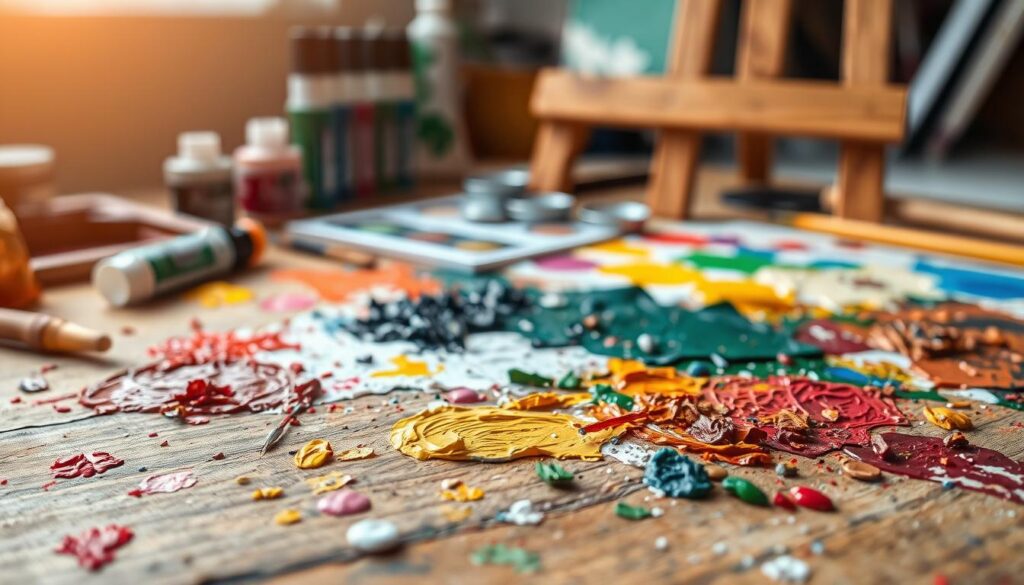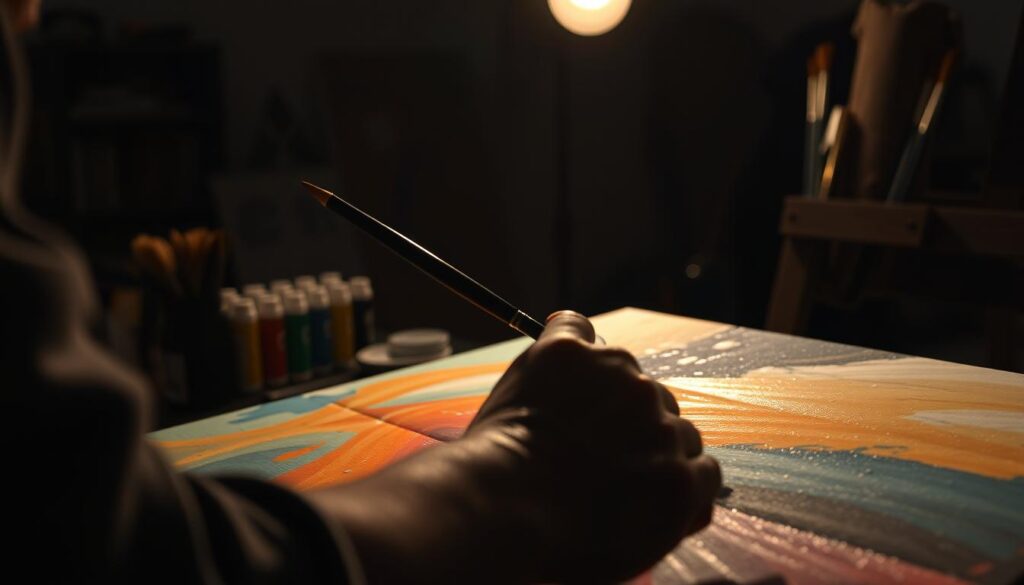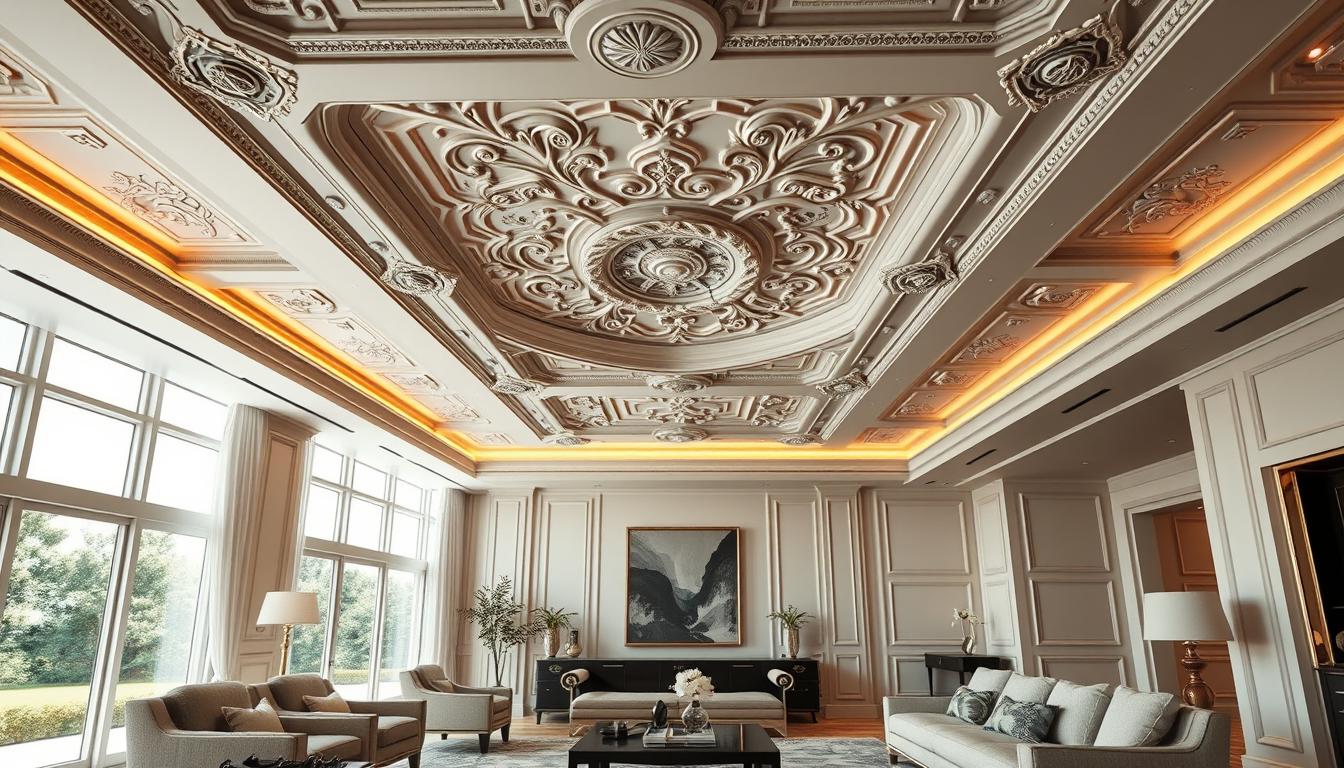A fresh coat of paint can change a room’s feel. It can turn an ordinary space into something amazing. Whether you want a calm retreat or a lively spot, the choices are endless with interior design.
Getting your space painted not only makes it look better but also increases your home‘s value. It’s a simple way to make any room feel more welcoming and personal.
Key Takeaways
- Enhance your home’s aesthetic appeal with a fresh coat of paint.
- Create a personalized space that reflects your style.
- Increase your home’s value with interior painting.
- Transform any room into a serene or vibrant space.
- Simple and effective way to breathe new life into your home.
Understanding the Benefits of Interior Painting
When we think about painting our homes, we should know the many benefits it brings. Interior painting does more than just refresh our home’s look. It offers advantages that can make our living space better.
Enhancing the aesthetic appeal of our home is a key benefit of interior painting. With so many interior paint colors to choose from, we can pick colors that show our style and taste. This creates a warm and inviting atmosphere.
Enhancing Aesthetic Appeal
A new paint job can totally change a room’s feel. By picking the right interior paint colors, we can make rooms look bigger, cozier, or more lively. “The right color can completely transform a space,” say many interior designers.
Increasing Home Value
Home painting is a smart way to boost our home’s value. A well-painted interior can impress potential buyers, showing our home is well cared for.
Real estate experts say a professional residential painting job can pay off big time. It’s a simple way to make our home more attractive and valuable.
Improving Indoor Air Quality
Some paints today are made with low-VOC or VOC-free formulas. These can greatly improve indoor air quality. By picking the right paint, we can make our homes healthier for ourselves and our families.
Choosing eco-friendly paints is good for our health and the planet. As we decide on residential painting services or DIY projects, thinking about the environment is key.
Choosing the Right Paint Type for Our Needs
The success of our interior painting project depends on picking the right paint. There are many options, and knowing what each paint is like is key to getting the look we want.
Paint Finishes Explained
Paint finishes greatly affect how our paint looks and lasts. We have matte, eggshell, satin, and gloss finishes. Matte finishes hide imperfections well but aren’t as tough. Satin and gloss finishes are better at standing up to wear and tear, perfect for busy areas.
When picking a finish, think about what you want it to look like and how long it should last. For example, satin is great for families because it’s easy to clean.
Types of Interior Paint
There are mainly two types of interior paint: latex and oil-based. Latex paints are water-based, easy to clean up, and dry fast. They’re good for most painting jobs and are better for the environment.
Oil-based paints are less common inside because of their strong smell and slow drying. But, they give a hard, shiny finish. They’re best for trim and areas needing a glossy look.
Knowing the differences between these paints helps us pick the best one for our needs. Whether we want something easy to use or something that lasts long.
Eco-Friendly Paint Options
If we care about the environment, there are eco-friendly paint options. These paints use natural stuff, have low VOCs, and break down easily.
Choosing these paints helps the planet and makes our air cleaner. When picking eco-friendly paints, look for certifications from trusted groups to make sure they’re really green.
By thinking about what we need and want, we can find the perfect paint. It will make our home look great and match our values.
Preparing Our Space for Painting
Getting our home ready for painting is key to a smooth process. It involves several important tasks to get the best results.
Clear the Area
First, we need to clear the area of furniture, curtains, and other items. This prevents damage and ensures a clean space. For more details, check Home Depot’s guide on how to paint a room.
Protecting Furniture and Floors
Even with everything moved out, there’s still a chance of spills. We must protect our floors with drop cloths or plastic sheets. Furniture should be covered with tarps or plastic covers.
Repairing Walls and Surfaces
It’s important to check walls for imperfections and fix them. This means filling holes or cracks with spackling compound and sanding it smooth.
| Preparation Task | Description | Tools Needed |
|---|---|---|
| Clearing the Area | Remove furniture and items from the painting area. | Furniture sliders, storage bins |
| Protecting Floors and Furniture | Cover floors and remaining furniture to prevent damage. | Drop cloths, plastic sheets, tarps |
| Repairing Walls | Fill holes and cracks, and sand to a smooth finish. | Spackling compound, sandpaper |
By doing these steps, we set our home painting project up for success. This leads to a professional-looking finish and a great outcome for our house painting project.
Selecting the Perfect Color Palette
Choosing the right color palette is all about color psychology and natural light. The colors we pick can really change how a room feels and works.
Using Color Psychology
Colors can make us feel different ways. Cool colors like blues and greens calm us down. Warm colors like oranges and reds make us feel more energetic. Think about the room’s purpose and the mood you want when picking interior paint colors.
Considering Natural Light
Natural light changes how paint colors look in a room. A color might look great in bright light but not in dim light. It’s smart to test paint samples at different times to see how they look under different lights.
Coordinating with Existing Décor
To make a room feel welcoming, our interior paint colors should match our décor. This includes furniture, flooring, and fixtures. We can use the colors in the room as a guide or choose something that contrasts nicely to add interest.
| Room Type | Recommended Colors | Effect |
|---|---|---|
| Bedroom | Soft blues, pale greens | Promotes relaxation |
| Living Room | Warm neutrals, earth tones | Creates a cozy atmosphere |
| Kitchen | Bright whites, vibrant colors | Stimulates appetite and energy |
By thinking about these things and using this guide, we can paint the interior of our home with confidence. We’ll create a space that’s both beautiful and functional, showing off our personal style.
Tools and Supplies We Need for the Job
For a perfect paint job, the right tools and supplies are key. We’ll cover what you need for a successful painting project.
Essential Painting Tools
First, we focus on the essential tools for a professional finish. These include:
- High-quality brushes in various sizes
- Rollers and extension poles for large areas
- Painter’s tape for sharp edges
- Paint trays and liners for efficient paint application
- Drop cloths or tarps to protect floors and furniture
Good brushes and rollers are crucial for a great finish. It’s worth investing in quality tools.
High-Quality Paint Brands
Picking the right paint brand is as important as choosing tools. Top brands known for quality include:
| Brand | Known For |
|---|---|
| Benjamin Moore | Wide range of colors and finishes |
| Behr | Affordable and high-quality options |
| Sherwin-Williams | Durable paints with excellent coverage |
These brands have paints for various surfaces and conditions.
Safety Gear and Precautions
Safety is our top concern when painting. We should use:
- Masks or respirators to avoid inhaling fumes
- Goggles to protect our eyes from splatters
- Gloves to keep our hands clean and protected
- Ladders and step stools that are sturdy and secure
Following these precautions ensures a safe and successful painting job.
As we get ready for painting, remember that tool quality affects the outcome. Choosing the right equipment and following safety rules helps achieve a professional finish. This enhances our home’s beauty and value.
“The way you paint can be just as important as the paint you choose. Using the right tools and techniques can make all the difference in the final result.”
Mastering Painting Techniques
Learning about painting techniques is crucial for a successful home painting job. Whether painting one room or the whole house, the right methods can greatly improve the look. A professional finish is within reach with the right techniques.
Brush vs. Roller
Painting uses two main tools: brushes and rollers. Each has its own benefits and is best for different tasks. Brushes are great for detailed work like edges and corners, offering precision. Rollers are best for big, flat areas, covering them quickly and evenly.
Choosing between a brush and a roller depends on the project’s needs. Brushes are better for trim and baseboards because of their precision. Rollers, on the other hand, are faster for ceilings and large walls, ensuring a smooth coat.

Cutting In Corners and Edges
Cutting in is a key step in painting, focusing on edges and corners. It requires the right brush and technique for a clean line. Use a high-quality brush with angled tips for better control.
- Load the brush with the right amount of paint to avoid drips.
- Paint in smooth, steady strokes, working from the top down.
- Use painter’s tape to protect trim and adjacent surfaces if necessary.
Achieving a Smooth Finish
A smooth finish comes from good preparation and the right painting techniques. To get this, we should:
- Ensure the surface is clean, dry, and free of dust.
- Apply a primer if necessary, on bare wood or stained areas.
- Use a high-quality paint that’s right for our surface.
For an even smoother finish, use a foam roller for the final coat. It leaves fewer marks than traditional rollers.
| Technique | Tool | Best For |
|---|---|---|
| Cutting In | Brush | Edges, Corners, Trim |
| Rolling | Roller | Large Surfaces, Ceilings |
| Smooth Finish | Foam Roller | Final Coat on Smooth Surfaces |
Creating a Painting Schedule
A well-planned painting schedule is key to a successful interior painting project. It helps organize the task, manage time, and keep the project on schedule and budget.
To make a good schedule, we must think about a few things. These include the area size, coat number, and drying time between coats. Let’s look at these details.
Timing It Right
Timing is crucial for residential painting. We must watch the weather, if painting outside, and the paint drying time. Picking the right time can greatly affect the finish quality.
For inside painting, we should plan around our daily routine. This helps avoid disrupting our daily life.
Setting Realistic Goals
Setting achievable goals is vital for our painting project’s success. We should break the project into smaller tasks and set enough time for each.
This way, we avoid last-minute stress and make sure each part gets the right focus. Being flexible and ready for delays is also key.
Budget Considerations
The budget is important for our painting project’s scope and timeline. We need to set aside money for paint, tools, and extra services like painting services for tricky areas.
By planning our budget well, we can keep our project financially on track. This way, we avoid surprise costs.
In summary, making a painting schedule means careful planning, setting realistic goals, and managing the budget. By doing these things, we can have a successful interior design project. It will make our home look better and increase its value.
Tricks for a Professional-Looking Finish
Getting a professional finish when painting your home’s interior takes some key steps. A good paint job can make your home look new and well-kept. It’s all about the details.

Working with Primer
Primer is a must for a top-notch finish. It creates a base coat that lets paint stick well. It’s vital for surfaces that are stained or uneven.
Primer is also key when painting over dark colors or bold patterns. It helps the new color show up evenly. Professional painters say primer makes a big difference.
Multiple Coats vs. One Coat
Choosing between one or multiple coats depends on the paint and surface. One coat might seem quicker, but it often looks uneven. This is true if the new color is very different.
Going for multiple thin coats gives better coverage and a smooth finish. It also cuts down on drips and streaks. Make sure each coat dries before adding the next for the best look.
Managing Paint Application
Effective paint application is key for a pro finish. Use top-notch brushes and rollers and the right techniques. For example, a ‘W’ or ‘M’ pattern with rollers spreads paint evenly.
Paint in sections and keep a wet edge to avoid lap marks. This method ensures a smooth finish. Also, adjust the paint’s thickness for a smoother application.
Maintenance and Touch-Ups After Painting
Keeping your home’s interior paint looking good is more than just about looks. It’s also about protecting your investment. After painting your home, it’s key to take steps to make the paint last longer.
Cleaning Painted Surfaces
Cleaning painted surfaces regularly is crucial to keep them looking great. Use a soft cloth and mild soap to wipe down walls. Stay away from harsh chemicals or abrasive materials that can harm the paint.
For stubborn stains, try a mix of baking soda and water. Put the paste on the stain, wait a few minutes, then scrub and rinse. This works well in kitchens and bathrooms where grease and grime build up.
Identifying Wear and Tear
Painted surfaces will show signs of wear and tear over time. It’s important to spot these issues early to avoid bigger problems. Look for cracks, fading, or chipping paint.
Regular checks can help us catch these problems early. Pay special attention to areas around doors, windows, and high-traffic zones, as they tend to get damaged more.
When to Repaint
Knowing when to repaint is as important as the initial painting. If you see a lot of fading, chipping, or if the paint looks dull, it might be time to repaint.
Repainting can not only update your home’s look but also add extra protection against the weather. When picking new interior paint colors, think about current trends and how they’ll affect your home’s feel.
By following these tips and keeping up with maintenance, we can make our home painting projects last longer. This way, our homes stay looking their best.
The Cost of Interior Painting
When planning an interior painting project, it’s key to understand the costs. The total cost depends on supplies, labor, and whether we hire pros or do it ourselves.
Budgeting for Essential Supplies
We must consider the cost of paint, brushes, rollers, and tools. High-quality paint may be pricier but offers better coverage and lasts longer.
Hiring Professionals or DIY
Choosing between hiring pros and DIY depends on our budget, time, and skills. DIY can save money, but pros ensure a top-notch finish, which is valuable for big projects.
Long-Term Value of Interior Design
Investing in interior painting boosts our home’s design and value. A well-done painting job can make our living space more enjoyable. It also increases appeal to buyers if we sell later.


